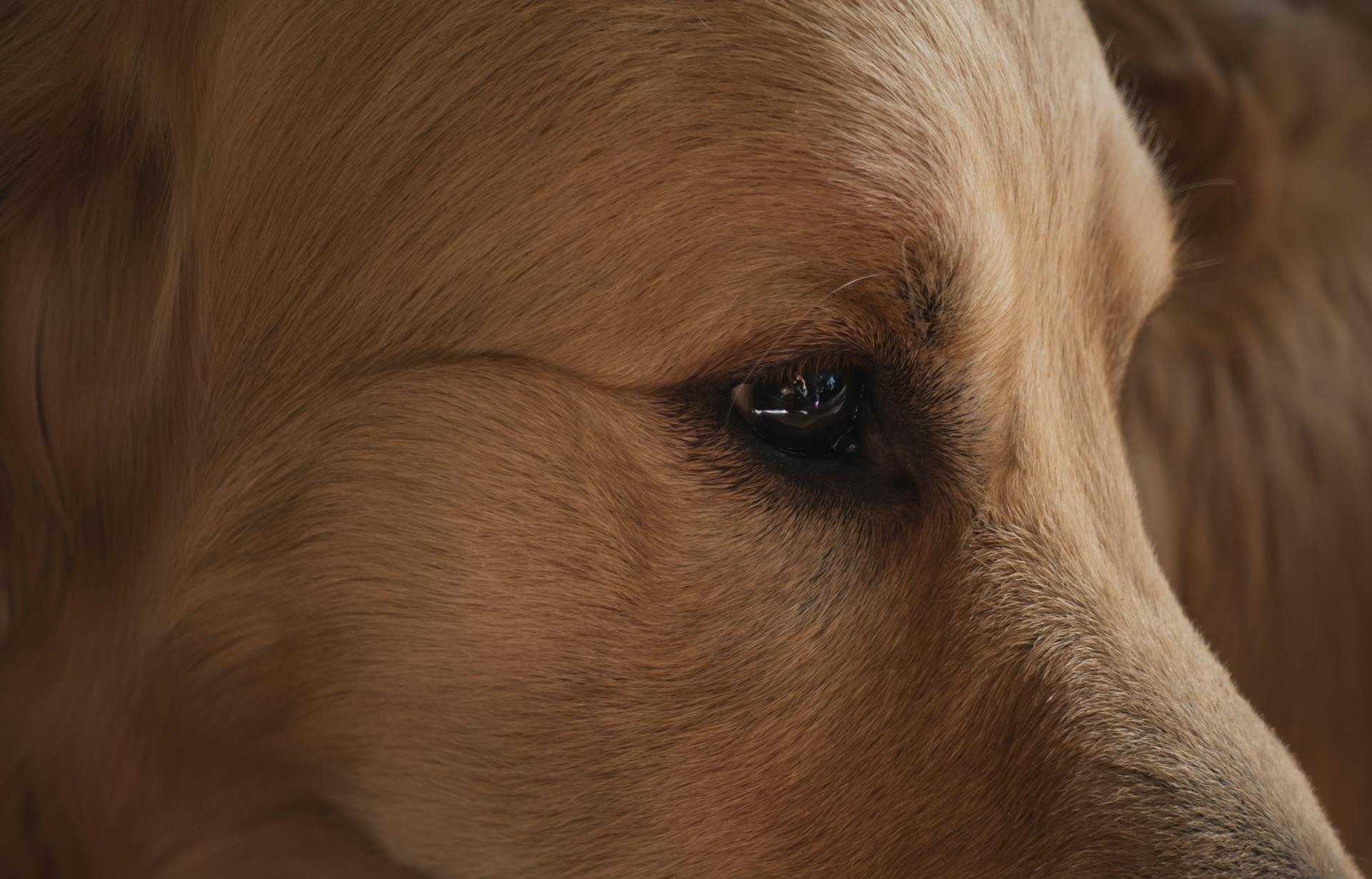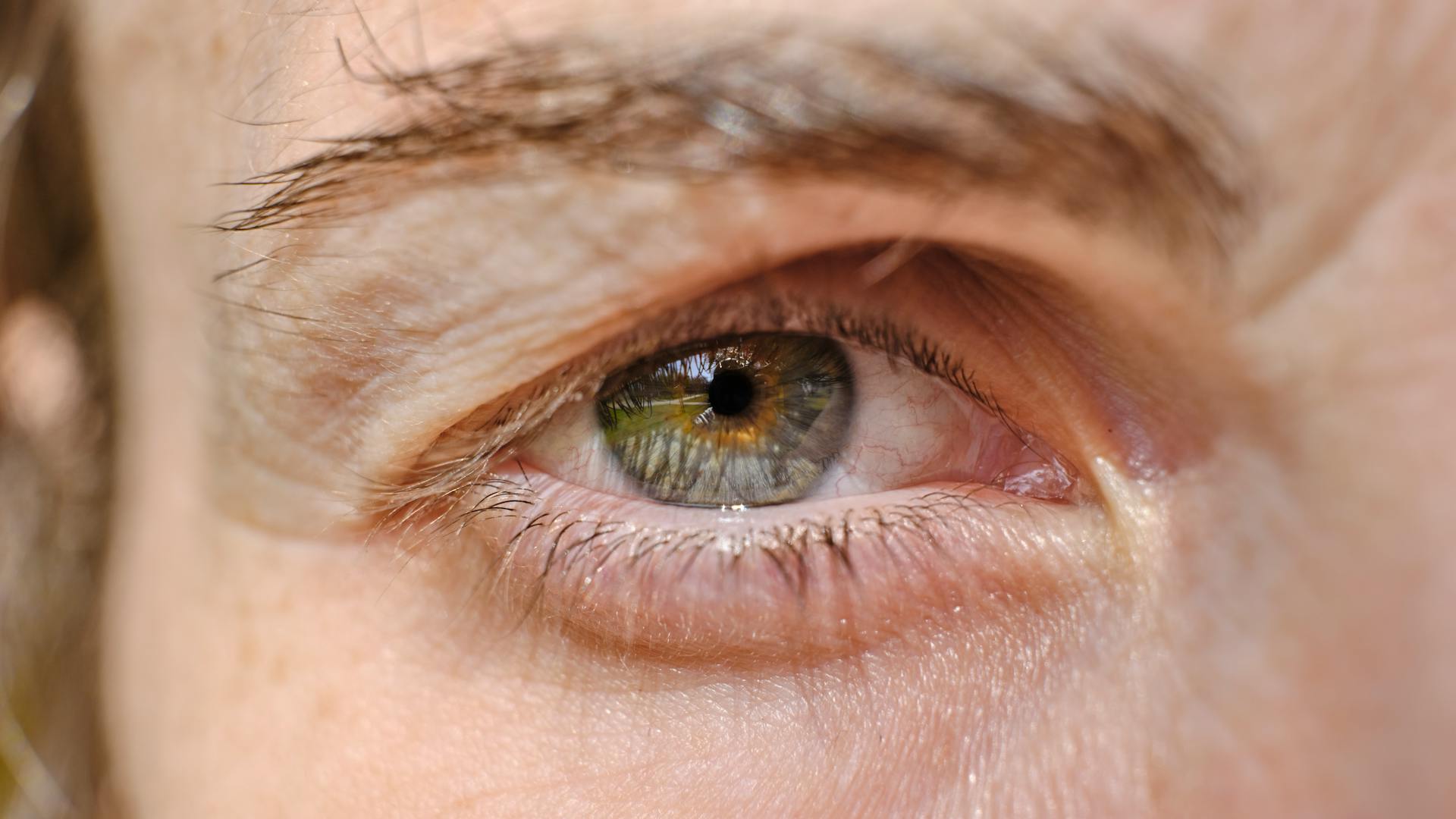
A dog's vision can be significantly impacted by cataracts, which are cloudy areas that form in the lens of the eye. This can cause vision loss and blindness.
Cataracts can develop in one or both eyes and are more common in older dogs. In fact, by the age of 10, almost 50% of dogs will have developed some degree of cataract formation.
Dogs with cataracts may exhibit symptoms such as sensitivity to light, blurred vision, and difficulty navigating around objects.
See what others are reading: Cataracts in Dogs with Diabetes
What Are Dog Cataracts?
Dog cataracts are an eye condition where the lens becomes cloudy and blocks light from reaching the retina.
Cataracts develop when proteins in the eye clump together, forming a hazy film over the lens.
This cloudy film can cover small parts of the lens or the entire lens.
Cataracts in dogs are classified into four stages: incipient, immature, mature, and hypermature.
Incipient cataracts affect less than 15% of the lens and don't cause vision issues.
Immature cataracts cause mild visual deficits because they affect multiple lens layers or different lens areas.
Mature cataracts cover the entire lens, resulting in significant vision loss or near blindness.
Hypermature cataracts occur when the cloudy lens shrinks, triggering lens-induced uveitis or eye inflammation.
A different take: What to Feed Dogs without Dog Food
Symptoms and Signs
Cataracts in dogs can be challenging to spot initially, but a cloudy lens is the early sign of cataracts in dogs. The cloudiness or opaqueness covers the entire lens or a small surface of the lens and is present on one or both eyes.
You might notice other symptoms if your dog has an underlying condition that's causing the cataract, such as thirst or frequent urination if they have Diabetes Mellitus. Eye pain can also be a sign of an underlying condition, like glaucoma, and might manifest as head shyness, squinting, or aggression.
The first indication of cataracts in dogs without an underlying condition might be cloudy eyes, which are a result of protein clumps accumulating within the lens. Cloudy eyes manifest as opacity with whitish, bluish, or grayish tones.
If your dog develops cataracts in both eyes, you're more likely to notice changes in their vision, such as night blindness or tentativeness when walking at dusk or dawn. They might also seem more clumsy by tripping or walking into things as their cataracts progress.
Check this out: Dog Barking at Other Dogs While Walking
Causes and Risk Factors
Dogs can develop cataracts due to various factors, including age, genetics, and certain health conditions.
Age is a significant risk factor for cataracts in dogs, with small breeds developing them around 10 years old and large breeds at 6 years old.
Genetics play a crucial role, with some breeds like Miniature Schnauzers, Poodles, and Terriers being more prone to cataracts.
Diabetes Mellitus is another significant risk factor, as excess blood sugar in dogs with diabetes can accumulate in the lens and cause cataracts.
Injury, nutritional deficiencies, and inflammatory conditions like uveitis can also contribute to cataract development in dogs.
Here's a breakdown of the common causes of cataracts in dogs:
- Age: 10 years old for small breeds, 6 years old for large breeds
- Genetics: Certain breeds like Miniature Schnauzers, Poodles, and Terriers
- Diabetes Mellitus: Excess blood sugar in dogs with diabetes
- Injury: Traumatic injuries, electric shock
- Nutritional Deficiencies: Lack of essential amino acids like tryptophan
- Inflammatory Conditions: Uveitis
What Are the Causes of?
Dog cataracts are a serious condition that can affect your furry friend's quality of life. Age is a significant contributor, with middle-aged to senior dogs being the most common victims of cataracts due to prolonged oxidative stress on the lens's epithelial cells.

Genetics play a crucial role in cataract development, with certain breeds like Miniature Schnauzers, Poodles, and some Terriers being predisposed to this condition. This is why it's essential to research your dog's breed and genetic history.
Diabetes Mellitus is another significant risk factor, with diabetic dogs being highly susceptible to cataracts. Excess blood sugar in dogs with diabetes accumulates in the lens, eventually resulting in cataracts.
Traumatic injuries, such as electric shocks, can also cause cataracts in dogs. This is a common cause of cataracts in dogs that have been exposed to such injuries.
Here are some common causes of dog cataracts:
- Age: Middle-aged to senior dogs
- Genetics: Miniature Schnauzers, Poodles, and some Terriers
- Diabetes Mellitus: Diabetic dogs
- Injury: Electric shocks and other traumatic injuries
Breed Prone to
Some breeds are more prone to developing cataracts due to their genetic makeup. Miniature Schnauzers, for instance, are one of the breeds that are more susceptible to cataracts.
Certain breeds are more likely to develop cataracts due to inherited genetic defects. According to a study, cataract-associated risk genes are present in 59 dog breeds.
Here's an interesting read: Dog Breeds Watch Dogs
Cocker Spaniels, French Bulldogs, and Huskies are also among the breeds that are more prone to cataracts. It's essential to note that just because a breed is prone to cataracts, it doesn't mean that every dog of that breed will develop them.
Here's a list of some breeds that are more likely to develop cataracts:
- Miniature Schnauzers
- West Highland Terriers
- Silky Terriers
- Boston Terriers
- Australian Shepherds
- Poodles
- American Staffordshire Terriers
- Labrador Retrievers
- Bichon Frise
- Havanese
- French Bulldogs
- Cocker Spaniels
- Husky
It's worth noting that some breeds, like Labradors and Golden Retrievers, are also prone to inherited cataracts.
Diabetic
Diabetic dogs are highly susceptible to cataracts, with about 75-80% developing them within the first year of diagnosis. This is a concerning statistic, as cataracts can lead to severe lens-induced uveitis and even glaucoma.
The connection between diabetes and cataracts is well-established, with excess blood sugar being the primary culprit. When a dog has diabetes, its body can't effectively remove excess glucose, leading to its accumulation in the lens.
Preventing high blood sugar levels in dogs is crucial in avoiding diabetes-related cataracts. Obesity, often caused by poor nutrition and lack of exercise, is a significant risk factor for canine diabetes.
A unique perspective: Homemade Dog Food for Dogs with Diabetes

A study published in Veterinary Ophthalmology found that the majority of dogs with diabetes will develop cataracts within 5-6 months of diagnosis. Approximately 80% of dogs will develop cataracts within 16 months of diagnosis.
Here are some key statistics to keep in mind:
Lead and Glaucoma
Cataracts in dogs can lead to glaucoma due to inflammation of the eye's middle layer, the uvea or uveal tract, which affects the eye's internal pressure.
Untreated cataracts cause lens-induced uveitis, a condition that can result in glaucoma.
Severe uveitis and other eye problems in dogs can cause eye hypertension or glaucoma.
Immunity's Role in Cataract Development
Your dog's immunity plays a crucial role in preventing cataract development. A strong dog immunity resists pathogens responsible for uveitis, a common risk factor for cataracts in dogs.
Severe and prolonged inflammation of the eye, known as uveitis, is a risk factor for cataracts in dogs. This is because uveitis can lead to cataract formation over time.
A robust immune response is vital for preventing infectious diseases that can cause uveitis. This is especially true for dogs that are prone to eye infections.
Medical Management
Medical management of cataracts in dogs involves maintaining comfort and preventing secondary complications. This approach doesn't restore vision, but it's crucial for preventing painful issues like lens luxations, glaucoma, and corneal ulcerations.
A visit to a veterinary ophthalmologist is necessary to determine the level of inflammation and decide on the best course of treatment. They may recommend topical NSAIDs, such as diclofenac or ketorolac, and eye lubricants to manage inflammation and promote healing.
Corneal health is a concern, especially in senior and diabetic pets. Poor corneal health can limit the use of NSAID medications, so it's essential to monitor tear film assessment with Schirmer tear testing and fluorescein staining for active or recent ulcerations.
Long-term medical management can involve daily NSAIDs and lubricants, as well as monitoring eye pressure changes and corneal health. Many dogs can lead happy lives with cataracts as long as they're pain-free and able to adapt to their surroundings.
Some dogs may not be candidates for surgery due to underlying conditions like retinal degeneration or detachment. These pets may require ongoing medical management to manage their condition and prevent further complications.
Here are some key takeaways to consider when managing cataracts in dogs:
- Topical NSAIDs and eye lubricants can help manage inflammation and promote healing.
- Corneal health is crucial, especially in senior and diabetic pets.
- Long-term medical management may involve daily medications and monitoring eye health.
- Some dogs may not be candidates for surgery due to underlying conditions.
Prevention and Detection
Regular eye inspections are crucial to detect early signs of cataracts in dogs. This can help reduce the risk of permanent blindness.
Routine checkups with a licensed veterinarian are essential for cataract-prone breeds.
Inspecting your dog's eye regularly can help identify issues early on. This can be a simple task that you can do at home.
Dog breeders should avoid breeding dogs with cataracts due to the condition's hereditary nature.
In case of eye injuries or trauma, take your dog to the veterinarian immediately. This can help prevent further complications.
Early detection of cataracts can make a significant difference in your dog's quality of life. It's essential to be proactive and monitor your dog's eye health closely.
Managing inflammation early on is key to effectively managing cataracts. This can be achieved with daily use of non-steroidal anti-inflammatory drug (NSAID) eye drop medications.
Consequences and Key Takeaways
If dog cataracts are left untreated, they result in blindness, significantly reducing a dog's quality of life. Blindness in dogs is a common complication of cataracts.
Dealing with a functionally blind dog at home is very challenging for owners, deeply affecting the human-animal bond.
Early detection and management of cataracts are imperative to give dogs the chance to have vision-saving surgery. Dogs with diabetes mellitus will develop cataracts quickly.
Low-grade inflammation is present in eyes even with immature cataracts, and controlling this inflammation gives more dogs the chance to have vision-saving surgery before secondary issues remove them from candidacy.
Frequently Asked Questions
Can a dog with cataracts see anything?
A dog with cataracts can still see some light, but their vision is significantly impaired. Without treatment, cataracts can progress to complete blindness.
How long can a dog have cataracts before they go blind?
Dogs with cataracts can lose their vision within 6-12 months if left untreated. The timeframe varies depending on the type of cataracts, with diabetic dogs at a higher risk of rapid vision loss.
Sources
- https://www.vet.cornell.edu/departments-centers-and-institutes/riney-canine-health-center/canine-health-information/canine-cataracts
- https://www.cliniciansbrief.com/article/cataracts-dogs
- https://www.honestpaws.com/blogs/health/dog-cataract
- https://todaysveterinarynurse.com/ophthalmology/early-detection-and-management-of-cataracts-in-dogs/
- https://anicira.org/resources/cataracts-in-dogs/
Featured Images: pexels.com


